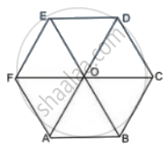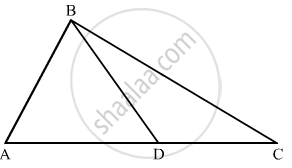Advertisements
Advertisements
प्रश्न
The area of a regular hexagon of side ‘a’ is the sum of the areas of the five equilateral triangles with side a.
विकल्प
True
False
उत्तर
This statement is False.
Explanation:
Given: The side of a regular hexagon is ‘a’.
As we know that the regular hexagon is divided into six equilateral triangles.
So, Area of regular hexagon = Sum of area of the six equilateral triangles.
APPEARS IN
संबंधित प्रश्न
A rhombus shaped field has green grass for 18 cows to graze. If each side of the rhombus is 30 m and its longer diagonal is 48 m, how much area of grass field will each cow be getting?
The sides of a quadrilateral, taken in order are 5, 12, 14 and 15 meters respectively, and the angle contained by the first two sides is a right angle. Find its are
Two parallel side of a trapezium are 60 cm and 77 cm and other sides are 25 cm and 26 cm. Find the area of the trapezium.
Find the perimeter and area of the quadrilateral ABCD in which AB = 17 cm, AD =9 cm, CD = l2cm, ∠ACB = 90° and AC=l5cm.
Let Δ be the area of a triangle. Find the area of a triangle whose each side is twice the side of the given triangle.
If each side of a triangle is doubled, the find percentage increase in its area.
The base of an isosceles right triangle is 30 cm. Its area is
The sides of a triangular field are 325 m, 300 m and 125 m. Its area is
The lengths of the sides of Δ ABC are consecutive integers. It Δ ABC has the same perimeter as an equilateral triangle with a side of length 9 cm, what is the length of the shortest side of ΔABC?
In the given figure, the ratio AD to DC is 3 to 2. If the area of Δ ABC is 40 cm2, what is the area of Δ BDC?

